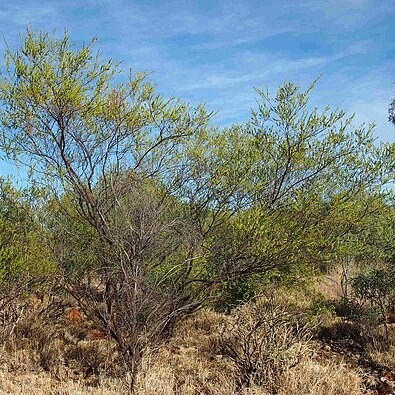Shrub to 6 m tall, multi-stemmed, spreading, resinous, often viscid. Bark 'Minni Ritchi' type, red-brown. Branchlets angular; ridges fawn, appressed-hairy; interstices green, glabrous, lenticellate. Stipules triangular, 0.5–2 mm long, persistent. Phyllodes linear-obovate, oblique, flat, 1–5 cm long, 1.2–5 (–7) mm wide, with a short apical point, coriaceous, with conspicuous stomata, glabrous or appressed-hairy on nerves and margins, with 2–5 ±conspicuous raised longitudinal nerves (all ±confluent and inconspicuous just below apex), with anastomosing nerves obscure on broad phyllodes; gland 1, basal. Spikes 0.7–3.7 cm long, golden. Flowers 5-merous; calyx 0.3–0.8 mm long, dissected for ½ their length or almost to base, ±glabrous; corolla 0.9–1.6 mm long, dissected for ⅓–½ their length, often papillous; ovary hairy. Pods slightly or variably more constricted between seeds or straight-sided, straight to strongly curved, flat, 2–10 cm long, 6–9 (–12) mm wide, thinly coriaceous to firmly chartaceous, obliquely reticulate, viscid; margins thick and yellowish. Seeds oblique, 4.2–5 mm long, black; areole closed, depressed, surrounded by a conspicuous pale halo.
More
A small shrub. It grows up to 2-4 m high. The bark is red and it curls up in narrow strips. The leaves (phyllodes) are 2-4 cm long and slender. They are rigid and thick and stick upwards. They are often sticky. They are dark green. The flower heads are like rods. They are 3 cm long and bright orange. The pods are 3-5 cm long and 0.6-1 cm across. They are flat, sticky and hard. The seed is small and hard. It is yellow where the seed joins the pod.
Details of utilisation of Acacia lysiphloia are given in L.A.J. Thomson & N. Hall, Australian Acacias no. 24, CSIRO Division of Forestry & Forest Products (1989).
More
The seed are reportedly eaten. Edible grubs are found in the roots.


